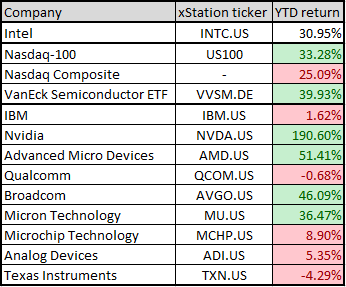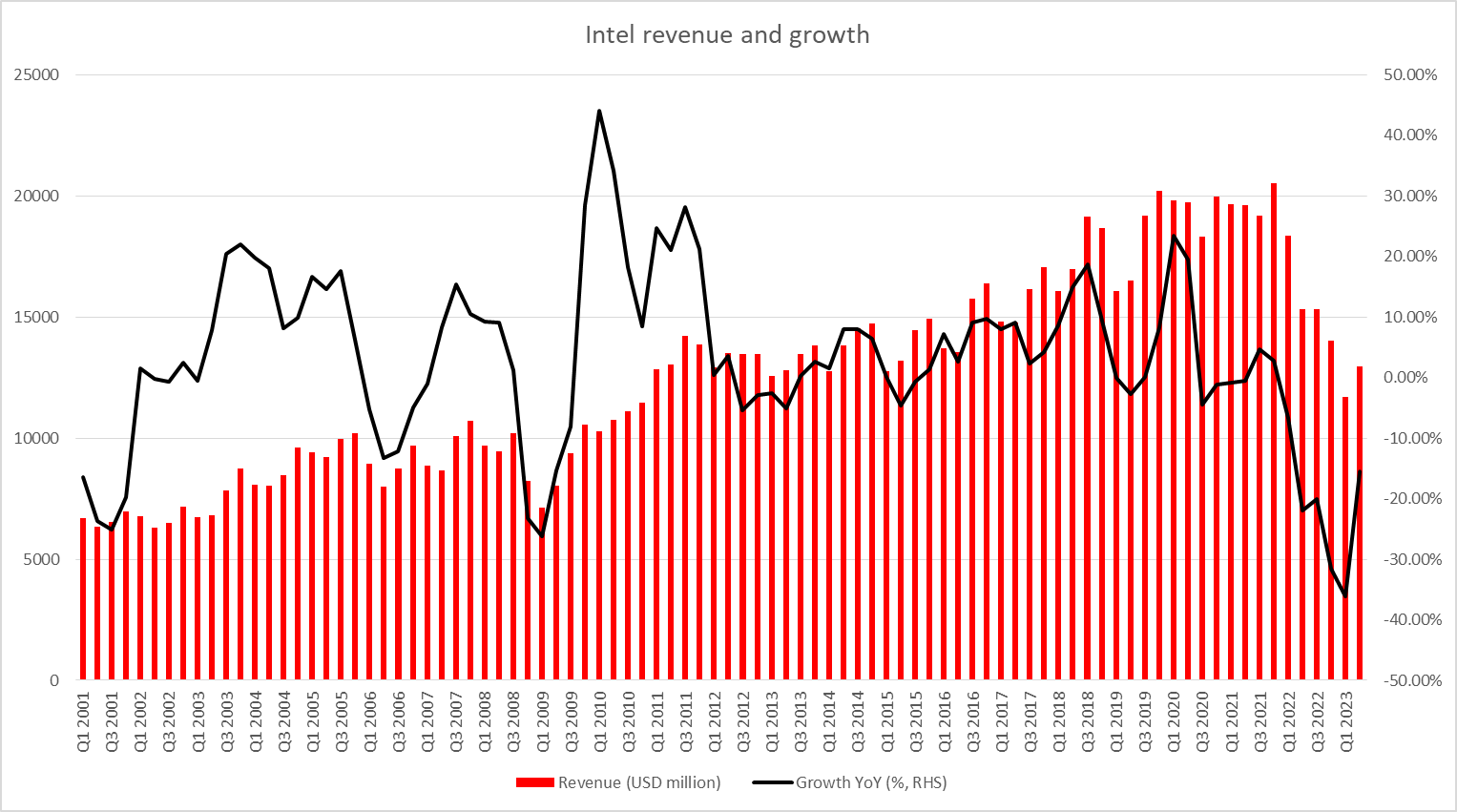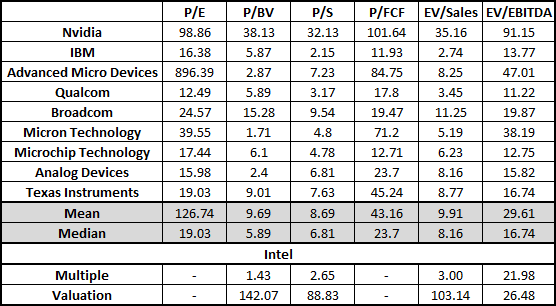- Intel has been lagging behind Nvidia and AMD
- Company underperformed during AI craze
- Nevertheless, Intel shares trade 30% YTD higher
- Hopes for PC demand revival and increased spending on AI chips
- Company slashed dividend by 65% at the beginning of 2023
- Share price tested the lower limit of the bullish channel
Tech shares have been stock market starts so far this year, especially during the first half of 2023. Gains on tech shares were driven by the AI craze, which pushed shares of companies like Nvidia or AMD to fresh all-time highs. However, one big name in the tech sector - Intel - has been struggling to keep up pace with leaders. Let's take a closer look at the company, whether it is really underperforming and how its valuation looks like.
Underperformance?
Start investing today or test a free demo
Create account Try a demo Download mobile app Download mobile appWhile a number of big name tech companies enjoyed a strong rally this year thanks to the AI craze, Intel has been lagging behind. It is true to some extent - Intel is not enjoying as strong gains as, for example, Nvidia or AMD and has not reached fresh record highs this year. However, this doesn't mean that it has missed on this year's tech sector rally altogether. In fact, Intel gained around 31% year-to-date. While this is lower YTD return than one achieved by Nasdaq-100 or VanEck Semiconductor ETF, it is higher than return delivered by a number of Intel peers.

Source: Bloomberg, XTB Research
Company tries to turn its business around
While Intel shares have not been underperforming the broad tech sector and its peers slightly, things look much worse when it comes to business. Company is experiencing issues in growing sales in its core PC segment. On top of that, the data center segment is also struggling and Intel keeps losing market share to its main rival AMD. However, there are signs that a turnaround may be around the corner. Some analysts see a potential for a rebound in the PC segment next year. Moreover, increased spending on generative AI is also expected to lead to an increased demand for CPUs. Nevertheless, it should be said that GPUs are more in demand in the AI sphere, so a massive Nvidia rally this year should not come as a surprise. Apart from improved outlook for Intel's core businesses, the company has also responded to recent deterioration in financials by engaging in cost-cutting measures.
 Source: Bloomberg Finance LP, XTB Research
Source: Bloomberg Finance LP, XTB Research
Valuation
Let's take a quick look at Intel's valuation with 3 often used valuation methods - DCF, multiples and Gordon Growth Model. We want to stress that those valuations are for presentation purposes only and should not be viewed as recommendations or target prices.
Discounted Cash Flow method
Let's begin with a discounted cash flow method (DCF). We have run a simplified DCF valuation, using 5-year averages as assumptions in the model. For terminal value assumptions we have used 5-year average WACC as terminal WACC and a 4% terminal revenue growth rate. Analysis horizon was set for 5 years after which a terminal value was calculated. DCF method with such assumptions leads us to Intel valuation of $43.22 - or almost 25% above current market price. Terminal value accounts for 80.8% of the forecast.
However, as usual a note of caution is needed. DCF is highly sensitive to assumptions made. Two sensitivity matrices are provided below - one for different Operating Margin and Revenue Growth assumptions and one for Terminal WACC and Terminal Revenue Growth assumptions.
Source: Bloomberg Finance LP, XTB Research
Source: Bloomberg Finance LP, XTB Research
Multiples Comparison
Next, let's move to the multiple comparison for Intel. First, we have created a wide peer group of US chip companies including Nvidia, IBM, Advanced Micro Devices, Qualcomm, BroadCom, Micron Technology, Microchip Technology, Analog Devices and Texas Instruments. However, this year's rally in Nvidia and AMD shares have significantly inflated their multiples and those have pushed means for the peer group higher. In order to overcome this, we have decided to use peer group medians. As Intel has achieved negative earnings and free cash flow in the 4 most recent quarters combined, P/E and P/FCF multiples cannot be calculated for Intel and valuations using peer group median would not make much sense (valuations would be negative). However, taking the average of valuations calculated using the four remaining multiples leads us to Intel valuation of $76.84 per share! This would signal that Intel shares are significantly undervalued but one should keep in mind that Intel is late to the AI party and its current valuation seem to reflect it (on top of rather poor fundamentals as well).

Multiple comparison of Intel and its peers. Source: XTB Research, Bloomberg Finance LP
Gordon Growth Model
The third valuation method we will use is Gordon Growth Model, a method based on dividends. Intel has a long track record of paying and rising dividends but a key point to note is that a massive dividend cut was made at the beginning of this year. Quarterly payout was slashed from $0.365 per share to $0.125 per share. That's a 65% reduction! Cumulative dividend for the most 4 recent quarters is $0.98 per share. Putting this value into Gordon Growth Model as well as historic cost of equity of around 9% and historic dividend growth of 6% as assumption leads us to a valuation of $34.63 per share - almost exactly in-line with current market price.
However, should we leave cost of equity and dividend growth assumptions unchanged but use the $0.50 per share value as annual dividend (4 quarters of $0.125 payouts), the model will provide us with a valuation of just $17.67 - almost 50% below current market price.

Sensitivity matrix for Intel's Gordon Growth Model with $0.50 used as annual dividend. Source: XTB Research, Bloomberg
A look at the chart
Last but not least, let's take a look at the technical situation on Intel's chart (INTC.US). Taking a look at the D1 chart, we can see that the 2021/22 downward move was halted in the $25 per share area around a year ago. A steady upward move can be observed since. Stock is moving within a bullish price channel since early-2023. However, a recent attempt at breaking above the upper limit of the channel turned out to be a failure and stock began to pull back. Price has retreated to and tested the lower limit of the channel this week but bulls managed to prevent a downside breakout. A near-term resistance to watch can be found in the $36.50 area while key resistance can be found in the $41.00 area where the upper limit of the channel as well as the 38.2% retracement of the 2021/22 downward move can be found. Key support to watch should we see a break below the lower limit of the bullish channel can be found at $33.05 and is marked with the lower limit of the Overbalance structure.
 Source: xStation5
Source: xStation5

